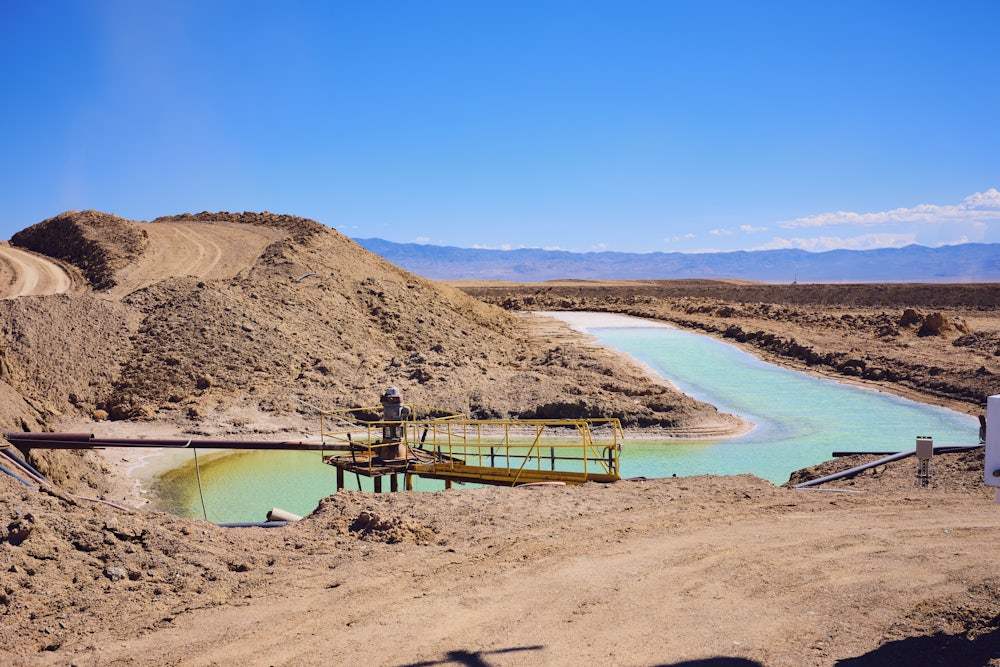Last week, The New York Times reported on the upcoming opening of what will be America’s second functional lithium mine—a signal of the nation’s official entrance into the current lithium boom, which is being driven by the worldwide transition to electric vehicles. Summarizing the fight over the open-pit mine that mining corporation Lithium Americas has proposed for a site in Nevada, the Times noted opposition from “members of a Native American tribe, ranchers and environmental groups.” The tribal nation is the Fort McDermitt Paiute and Shoshone Tribes, whose tribal government leader, Maxine Redstar, told the Times that, like so many other Indigenous nations, it had not been adequately consulted by Lithium Americas prior to the Department of Interior’s decision to grant the company a permit. It’s a carbon copy of the extractive operations being fought by the Quechan Tribe, the San Carlos Apache, the Standing Rock Sioux, and so many others: A new energy field offers jobs temporarily and environmental destruction forever.
What’s unusual about the Times’ lithium piece is that, unlike typical mainstream media coverage of a decade ago that would merely focus on a new extractive operation, it grants a quarter of the copy to highlighting the Paiute and Shoshone Tribes’ criticisms of the consultation process and the project. It’s a sign of how American media is trying to center Indigenous interests during discussions of domestic energy production. In almost any other circumstance, it would land as a welcome instance of representational reporting.
But when you take a step back and consider it alongside the countless others published in the past few years, the Times piece ultimately follows a troubling trend in both media and government: Currently, the sovereign rights of Indigenous nations are seen as one priority among many, often having to give way to others. The United States is still very far from treating Indigenous rights as a mandate, a hard line that cannot be crossed. And as the country attempts to transition to a new energy system that won’t kill the planet, there’s a serious danger that it will willingly default to the most familiar path.
“The mine, constructed on leased federal lands, could help address the near total reliance by the United States on foreign sources of lithium.” That’s the second sentence of the Times piece—the way the reader is primed to understand this story long before any Paiute and Shoshone citizens are quoted. The allegedly supreme goal of domestically sourced energy has a long history of overshadowing human rights. If you were around for the shale boom of 2008, that line, and its prominent placement in the article, likely reads familiar.
Like many outlets, the Times during the shale boom published a steady stream of articles that sought to wrestle with What It All Meant—situating environmental concerns alongside the material conditions of economically distressed communities in need of steady employment, and all tucked under the overwhelming truth that American energy independence is the best and only way forward. The environmental, spiritual, human, or sovereign rights of Indigenous people rarely got a space above the fold or were allowed to anchor a story.
The Standing Rock protests over the Dakota Access pipeline changed this dynamic: Prior to that public rejection of the international pipeline, the media landscape had little use for presenting an Indigenous perspective in its climate coverage. Take this rhetorical Q&A the Times ran in 2014 about the “pros and cons” of the Keystone XL pipeline: Despite the paper using the lead image of a Native man being arrested for protesting the pipeline, the words “tribe,” “sovereignty,” “tribal consultation,” or “Indigenous” were neither printed or referenced. Instead, that man, and Water Protectors throughout the media, were mostly lumped under the broad category of “environmentalists.”
Now Native people are no longer an afterthought for the climate desks of the nation’s largest outlets, hence pieces like the Times’ lithium exploration. But tribal citizens and nations are not quite the focus, either. Rather, the industry seems to be in something of a limbo at the current moment: The most prominent news stations, newspapers, and magazines have decided that including Indigenous voices in their stories is worthwhile and necessary. But granting Native journalists editorial power in their newsrooms or centering Native subjects and sources in their produced narratives still seems to be a bridge too far.
We as a species stand at a critical juncture in time, wherein we collectively have to decide, one, whether this planet is worth saving, and two, whether nations constructed by colonial, extractive, anti-Indigenous practices can effectively unlearn what they’ve spent centuries perfecting and codifying.
The Biden administration has declared its broad intentions to use its power to stave off the climate crisis. And it has also been moderately impressive in marrying that commitment to an adjacent promise to respect the sovereign rights and powers of tribal nations. The “30 by 30” conservation plan the administration rolled out last week frequently highlights the need for federal agencies to partner with tribal nations on land and resource management plans moving forward. It also reminds all federal agencies of their legal duty to conduct thorough consultation processes with any tribes affected by a potential development. This largely holds with the statements and directives that have been issued thus far by both Biden and Interior Secretary Deb Haaland, a Laguna Pueblo citizen and the first Native official tapped to head a Cabinet-level department.
Clearly, this is progress. But when it comes time to create long-term solutions to these issues, neither the federal government nor the national media seem quite ready simply to acknowledge there are hard boundaries of Indigenous sovereignty and human rights that you don’t get to trump with a “national interest” argument.
Where the White House swiftly stepped in to block Keystone XL, the administration’s Army Corps of Engineers has punted twice on the Dakota Access pipeline, despite the fact that the pipeline is vehemently opposed by three tribal nations whose lands and waters it would potentially poison. Likewise, the administration has not yet issued a position on the policy item of Free, Prior, and Informed Consent, which would bolster the current consultation process by granting tribal nations more power to reject proposed development projects on their lands. Multiple tribal leaders voiced the need for FPIC in the consultation calls held with the Interior earlier this spring. House Representatives Raúl Grijalva and Alan Lowenthal sent a letter, co-signed by 15 other members of Congress, to Haaland and Agriculture Secretary Tom Vilsack in late April, calling on the secretaries to adopt a regulatory framework specifically for mining projects that begins with introducing FPIC.
Indigenous issues are a priority, clearly, but often a lesser one. Establishment media is getting much better at including Native voices in its pieces, but often lacks them on mastheads and in leadership positions. The Biden administration has far more to say about Native sovereignty than its predecessors but also very badly wants to win reelection come 2024 and outmaneuver China in a race to global battery dominance, both of which goals could lead to mass resource extraction efforts in order to create blue-collar jobs and power renewable technology. (Whether this is actually the best path to fight climate change or win reelection is debatable.) Department of Energy Secretary Jennifer Granholm said as much in the Times: “China just put out its next five-year plan. They want to be the go-to place for the guts of the batteries, yet we have these minerals in the United States. We have not taken advantage of them, to mine them.” And it is ultimately Granholm’s perspective—not the tribal citizens’—that the Times uses to frame the issue.
The day before the Times published its article, the International Energy Agency inadvertently detailed what the future fights over Indigenous land rights will entail, releasing a report that found the global need for “critical minerals” may increase sixfold over the next two decades. That means more lithium mines, more cobalt mines, more copper mines, and more nickel mines.
This administration is admittedly stuck with the unenviable balancing act of respecting its nation-to-nation relationship with nearly 600 tribes while pandering to an electorate that will just as happily vote for an opponent that outright rejects the very reality of the climate crisis. That’s likely why the White House, at least for now, does not seem keen on canceling new natural gas pipelines or the nation’s remaining coal plants (or the pig-poop offshoots) without first being able to show voters alternative industrial jobs in green energy. To build that alternative, the federal government will undoubtedly look to approve mining pits and solar fields on Native land, regardless of whether the tribal nation agrees to it. To think otherwise is to ignore everything that has come before: the copper mine at Oak Flat, the phosphate mine underneath the Fort Hall rez, the uranium mines littered about Navajo Nation, the pipeline cutting through Standing Rock, and any of its many cousins.
This is not a uniquely American issue. Reporting for E360, Colombian journalist María Paula Rubiano recently laid out the case of the Wayúu peoples, whose lands in the La Guajira desert are now being eyed by the Colombian federal government for a massive wind turbine development. And as my own colleague Kate Aronoff reported in 2019, while the U.S. would love to tap into the deposits on this continent, it has so far been the Indigenous communities of Bolivia, Argentina, and Chile that have suffered in the name of providing America with 93 percent of its lithium supply.
Preemptively instituting measures like FPIC or canceling the Dakota Access pipeline would likely damage the Democratic Party’s short-term political viability. It would alienate corporate executives, labor representatives, and probably a great number of Native entrepreneurs. Likewise, writing a story that frankly framed the Nevada lithium mine as part of an enduring pattern of neocolonialism would probably alienate Democratic operatives, White House officials, and tribal officials with extractive-based economies. But presenting sustainable American energy and Indigenous rights as an either-or choice is nonsense. As complex as these issues are, the truth about what awaits us in the coming years is pretty simple: There will be no “just” transition in the U.S. or anywhere else if today’s global powers refuse to decolonize their energy production models.








